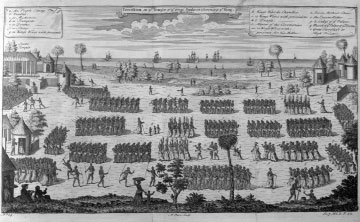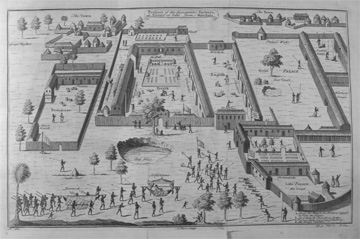Ouidah


Ouidah (also known as Whydah) is a commercial center in the modern African nation of Benin that was one of the most active slave trading ports in all of Africa. Europeans called the Bight of Benin—where Ouidah is located—and the surrounding region the “Slave Coast” because of its importance in supplying American markets with African laborers. Historians estimate that over the course of two centuries, Ouidah alone exported more than one million Africans before closing its trade in the 1860s. Only one other port in Africa (Luanda, in Central Africa) transported a greater volume of slaves.
The earliest European settlement in Ouidah began near an existing African town there in the late 1600s, but did not become well established until 1704, when French traders built a fortified trading post. Over time, traders representing several different European nations constructed their own forts to tap into the town’s growing markets. In 1727, the Kingdom of Dahomey conquered Ouidah and its African political leadership. This process eventually helped to increase the size of Ouidah and, in turn, its commercial importance.
Ouidah’s population was predominantly African. Only a few hundred European residents lived there through much of the eighteenth and early nineteenth centuries, while the overall population grew from less than 10,000, to almost 30,000 in the same period. As was the case in some other slave trading ports, sale of captive Africans at Ouidah was managed in part by an African royal monopoly, but was largely conducted by private merchants. These middlemen supplied captives from the African interior who had been taken by Dahomean state military campaigns or who had been purchased from other inland traders.
Ouidah was an important supplier of slaves to Brazil generally, and to the region of Bahia in particular, even after the trade became increasingly illegal after the early decades of the nineteenth century. After 1840, international diplomacy, law, and enforcement severely restricted Ouidah’s ability to sell African captives. While traders there continued to fill slave ships for a few decades more, the city began to shift toward other commodities—especially palm oil—leading to a decline in Ouidah’s size and importance.
History & Memory
Related Pages:
-
 Oyo Empire
Oyo Empire
-
 Sculpture, Calabar’s Slave History Museum
Sculpture, Calabar’s Slave History Museum
-
 Antera Duke
Antera Duke
-
 Capture and Captives
Capture and Captives
-
 Ghana Museums and Monuments
Ghana Museums and Monuments

